
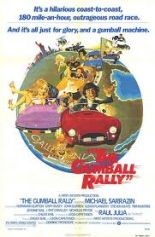 If you were to check the leaderboard for comedies about illegal cross-country road races, you’d find that The Gumball Rally is firmly in the #2 spot. Trailing behind Paul Bartel’s Cannonball (which is even better if you imagine it as an unofficial prequel to Death Race 2000), it’s still miles ahead of Hal Needham’s The Cannonball Run series, which are classic examples of how movies that were obviously a lot of fun to film, usually aren’t a lot of fun to watch. (And if you’re wondering about Speed Zone, everyone involved in that fiasco died crashing into the wall or, at least, they wish they did).
If you were to check the leaderboard for comedies about illegal cross-country road races, you’d find that The Gumball Rally is firmly in the #2 spot. Trailing behind Paul Bartel’s Cannonball (which is even better if you imagine it as an unofficial prequel to Death Race 2000), it’s still miles ahead of Hal Needham’s The Cannonball Run series, which are classic examples of how movies that were obviously a lot of fun to film, usually aren’t a lot of fun to watch. (And if you’re wondering about Speed Zone, everyone involved in that fiasco died crashing into the wall or, at least, they wish they did).
Starring Michael Sarrazin as a wealthy businessman who relieves his existential boredom by running an annual underground race from New York City to Long Beach, Calif., the film follows the same loose, character-based structure of all those other films (a mold whose origins can be traced directly to Stanley Kramer’s It’s a Mad, Mad, Mad, Mad World).
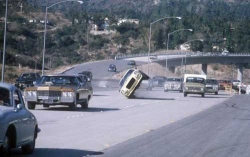 Although The Gumball Rally lacks the star power of Needham’s films, its lack of recognizable celebrities is mitigated by the fact that its cast actually made the effort to inhabit likable characters, rather than just mug shamelessly until the director announced it was time to get back to the hotel and par-tay.
Although The Gumball Rally lacks the star power of Needham’s films, its lack of recognizable celebrities is mitigated by the fact that its cast actually made the effort to inhabit likable characters, rather than just mug shamelessly until the director announced it was time to get back to the hotel and par-tay.
Director/writer Charles Bail keeps the film light and slightly cartoony, and although some moments don’t quite work, the majority of the film moves as quickly as the vehicles it depicts right until the finish line. —Allan Mott


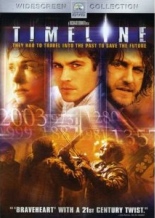
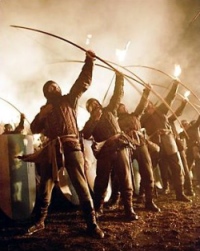 And how I wish I could go back in time to save myself two hours and four bucks. This is not a story — it’s an endlessly cycling collection of footage of knights falling down, students climbing out of houses, swords clanging, and our heroes checking their “countdown markers” to see how much time they have left to make their rescue. In the spirit of things, I kept checking the readout on my DVD player to see how much more crap was left to unload before the closing credits.
And how I wish I could go back in time to save myself two hours and four bucks. This is not a story — it’s an endlessly cycling collection of footage of knights falling down, students climbing out of houses, swords clanging, and our heroes checking their “countdown markers” to see how much time they have left to make their rescue. In the spirit of things, I kept checking the readout on my DVD player to see how much more crap was left to unload before the closing credits.
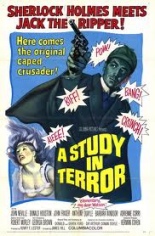
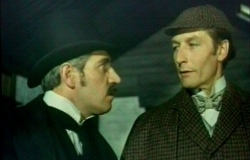 Plot? We’ve pretty much already said it. Like
Plot? We’ve pretty much already said it. Like 
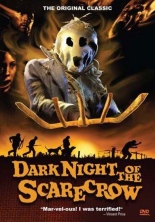
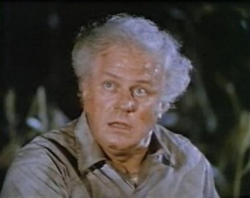 Bubba’s mom hides him in the scarecrow on their farm field, but the vigilante mob finds him and shoots him dead. And for nothing: Bubba saved the little girl’s life; ’twas a vicious dog to blame for her bloodiness. D’oh! Just desserts arrive as a scarecrow comes a-knockin’ for vengeance, one by one. You might say they get the short end of the straw. (Insert rimshot here.)
Bubba’s mom hides him in the scarecrow on their farm field, but the vigilante mob finds him and shoots him dead. And for nothing: Bubba saved the little girl’s life; ’twas a vicious dog to blame for her bloodiness. D’oh! Just desserts arrive as a scarecrow comes a-knockin’ for vengeance, one by one. You might say they get the short end of the straw. (Insert rimshot here.)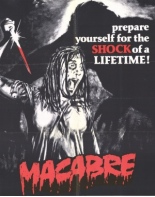
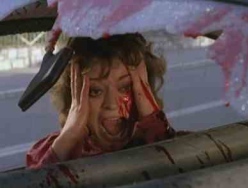 One year later, Jane is released from an asylum and moves into the old house where she and Frank used to meet. The blind landlord, Robert (Stanko Molnar), who has a crush on her, is glad she’s back until he starts hearing the sounds of passion issuing from her apartment as she calls out Frank’s name.
One year later, Jane is released from an asylum and moves into the old house where she and Frank used to meet. The blind landlord, Robert (Stanko Molnar), who has a crush on her, is glad she’s back until he starts hearing the sounds of passion issuing from her apartment as she calls out Frank’s name.